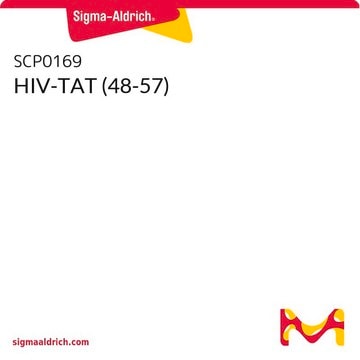H0292
HIV-1 Tat Peptide
≥97% (HPLC), lyophilized powder
About This Item
Empfohlene Produkte
product name
HIV-1 Tat Protein (47-57),
Biologische Quelle
synthetic
Qualitätsniveau
Form
lyophilized powder
Löslichkeit
deionized water: soluble
Versandbedingung
dry ice
Lagertemp.
−20°C
SMILES String
NCCCC[C@H](NC(=O)[C@H](CCCNC(N)=N)NC(=O)CNC(=O)[C@@H](N)Cc1ccc(O)cc1)C(=O)N[C@@H](CCCCN)C(=O)N[C@@H](CCCNC(N)=N)C(=O)N[C@@H](CCCNC(N)=N)C(=O)N[C@@H](CCC(N)=O)C(=O)N[C@@H](CCCNC(N)=N)C(=O)N[C@@H](CCCNC(N)=N)C(=O)N[C@@H](CCCNC(N)=N)C(O)=O
InChI
1S/C64H118N32O14/c65-25-3-1-11-39(89-50(101)38(13-5-27-81-59(69)70)88-48(99)34-87-49(100)37(67)33-35-19-21-36(97)22-20-35)51(102)90-40(12-2-4-26-66)52(103)91-41(14-6-28-82-60(71)72)53(104)92-43(16-8-30-84-62(75)76)55(106)95-45(23-24-47(68)98)57(108)94-42(15-7-29-83-61(73)74)54(105)93-44(17-9-31-85-63(77)78)56(107)96-46(58(109)110)18-10-32-86-64(79)80/h19-22,37-46,97H,1-18,23-34,65-67H2,(H2,68,98)(H,87,100)(H,88,99)(H,89,101)(H,90,102)(H,91,103)(H,92,104)(H,93,105)(H,94,108)(H,95,106)(H,96,107)(H,109,110)(H4,69,70,81)(H4,71,72,82)(H4,73,74,83)(H4,75,76,84)(H4,77,78,85)(H4,79,80,86)/t37-,38-,39-,40-,41-,42-,43-,44-,45-,46-/m0/s1
InChIKey
RAVVEEJGALCVIN-AGVBWZICSA-N
Amino Acid Sequence
Allgemeine Beschreibung
Biochem./physiol. Wirkung
Physikalische Form
Sonstige Hinweise
Lagerklassenschlüssel
11 - Combustible Solids
WGK
nwg
Flammpunkt (°F)
Not applicable
Flammpunkt (°C)
Not applicable
Analysenzertifikate (COA)
Suchen Sie nach Analysenzertifikate (COA), indem Sie die Lot-/Chargennummer des Produkts eingeben. Lot- und Chargennummern sind auf dem Produktetikett hinter den Wörtern ‘Lot’ oder ‘Batch’ (Lot oder Charge) zu finden.
Besitzen Sie dieses Produkt bereits?
In der Dokumentenbibliothek finden Sie die Dokumentation zu den Produkten, die Sie kürzlich erworben haben.
Kunden haben sich ebenfalls angesehen
Unser Team von Wissenschaftlern verfügt über Erfahrung in allen Forschungsbereichen einschließlich Life Science, Materialwissenschaften, chemischer Synthese, Chromatographie, Analytik und vielen mehr..
Setzen Sie sich mit dem technischen Dienst in Verbindung.









